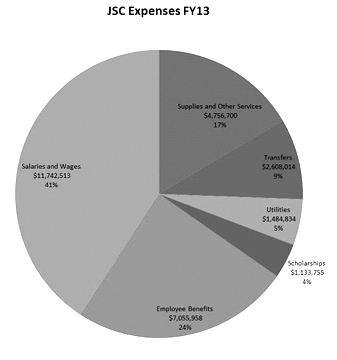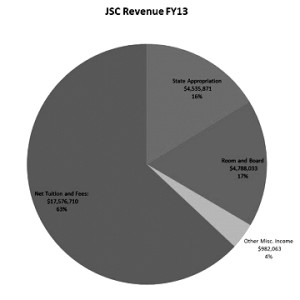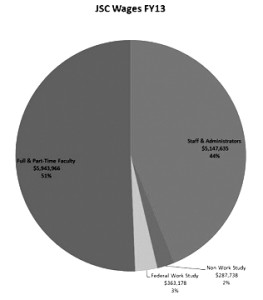JSC’s $30 million budget: where the money comes from, where it goes

JSC expenses, FY 2013
Thirty million dollars seems like a lot. Until you start spending it.
According to the JSC 2013 budget report, the college has a budget of almost $30 million. So, where does the money come from?
Although Vermont is a publicly-funded institution of higher learnng, legislative fiscal support for its five state colleges ranks last in the country. Consequently, the main source of revenue comes not from the State of Vermont, but from tuition and fees.
Sixty three percent of the revenue that the college takes in comes from tuition and fees, 17 percent comes from room and board, 16 percent comes from the state appropriation, and 4 percent comes from other miscellaneous income which, according to Dean of Administration Sharron Scott, consist of conference and events, renting spaces in the summer, camps, conferences, the health center, parking passes, gifts and grants, and annual fund grants.
As for possible tuition and fee increases for next year, the VSC board of trustees will determine the extent of increase, if any, during upcoming meetings.
Endowments that the college receives for specific items are not shown in the report.
And where does the money go?

Salaries and wages account for 41 percent of the budget; employee benefits 42 percent, supplies and other services 17 percent; transfers 9 percent, utilities 5 percent, and scholarships 4 percent.
Services and supplies include money the college pays to Sodexo for the meal plans, about $1 million, as well as any trips or travel. The upcoming Cuba trip is an example of the kind of trip that this portion pays for.
Scott says that there are three main cost drivers for the college, the first being salaries and wages. “The vast majority of our employee pool are represented by bargaining units” Scott said. “Therefore we have contracts we have to adhere to. The cost driver that’s attached to salaries and wages comes from having to meet our obligations.”
The salaries and wages category breaks down into 51 percent full and part time faculty, 44 percent staff and administrators, 3 percent for Federal work study that is paid for by the government and 2 percent non work study.
Scott noted the second cost driver is employee benefits and retirees. Crucial to this is the cost of health insurance. However, the Affordable Care Act may eventually make an impact on this. “At some point the employee benefits will be adjusted in the distant future if the Vermont State colleges gets to the point where it has a trust fund that it can use to pay ongoing retiree benefits,” Scott said. “That would reduce the overall portion of the budget because it would be paid from a different pool and not from Johnson State College’s ongoing operations budget.”

The last main cost driver is supplies, services and utilities. This price could be reduced, however, through a variety of energy conservation initiatives across the campus.
Ben Simone joined the Basement Medicine Staff in Spring 2014, assuming the position of staff reporter.


